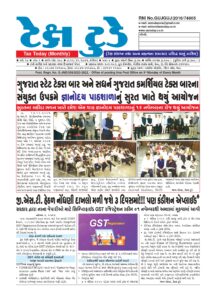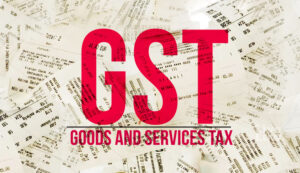GST WEEKLY UPDATE : 17/2022-23 (24.07.2022) By CA Vipul Khandhar

By CA Vipul Khandhar
- Advisory on Upcoming Changes in GSTR-3B:
The Government vide Notification No. 14/2022 – Central Tax dated 05th July, 2022 has notified few changes in Table 4 of Form GSTR-3B requiring taxpayers to report information on ITC correctly availed, reversal thereof and declaring ineligible ITC in Table 4 of GSTR-3B.
Input tax credit disclosure in Form GSTR3B Table Disclosure 4A.:
| Table | Disclosure |
| 4A. ITC Available | Total ITC (eligible as well as ineligible) auto-populated from GSTR-2B. (Except ineligible ITC due to time barred and POS of intra state supply is different from the recipient state/UT). |
| 4 B(1) ITC
Reversed |
ITC which are absolute in nature and not reclaimable:
Rule 38 (reversal of credit by banking company), Rule 42 (reversal of ITC on input and input services on account of exempt supply), Rule 43 (reversal of ITC on capital goods on account of exempt supply) & Section 17(5) ineligible ITC. |
| 4B(2) ITC
Reversed |
ITC which are not permanent in nature and can be reclaimable in future:
Rule 37 (reversal of credit due to non- payment within 180 days), Section 16(2)(b)&(c) (reversal due to invoice received earlier but goods and service received later). |
| 4C. Net ITC
Available |
4C=4A-(4B(1)+4B(2)) |
| 4D.(1) Ineligible
ITC |
ITC which was reversed in 4B(2)and now reclaiming the same, shall
also report here |
| 4D.(2) Ineligible
ITC |
Ineligible ITC due to time barred and POS of intra state supply is
different from the recipient state |
2. E-invoicing is likely to be soon notified for taxpayers with turnover above Rs. 5 Cr:
E-Invoice system says the taxpayers with turnover above Rs.5 crore are enabled for testing on the Sandbox system.
The e-invoice generation process to run smoothly, the government has mandated that all e-invoicing eligible businesses who wish to integrate their ERP systems with the e-invoice portal should carry out sandbox testing and submit the report for the same.
- To carry out sandbox testing for your business is to take on the services of a GSP/ASP (GST Suvidha Provider/Application Service Provider), who will integrate your ERP system with the e-invoice portal, fulfil the IT regulatory requirements set by the NIC, carry out sandbox testing and get your organisation e-invoicing ready.
- Second option is to directly integrate your ERP with the e-invoice portal and carry out the sandbox testing on your own. This can be done by visiting the sandbox testing portaland following the given instructions.
- Third option self, If you do not wish to integrate your ERP, you can also generate e-invoices using the bulk-generation Excel tool offered by the e-invoice portal. You will need to visit the e-invoice portal, and navigate to ‘Help’ -> ‘Tools’-> ‘Bulk Generation Tools’ and enter the required information to download the tool.
Facility given to know supplier liable for the E –invoice or not:
The obligation to issue e-invoices according to the terms of Rule 48(4) lies with the concerned taxpayer. However, any person can search for the status of enablement of a GSTIN on the e-invoice portal. Navigate to ‘Search’ -> ‘e-invoice status of the taxpayer’.
This listing of GSTINs is based solely on the turnover reported in GSTR-3B. This means that the list could also contain entities that are either exempt from e-invoicing or entities for whom e-invoicing is not applicable for some other reason. Hence, the e-invoice portal’s enablement status does not necessarily mean that the taxpayer is supposed to issue an e-invoice.
Applicability of e –invoice can be checked:
The taxpayer’s turnover slab can also be ascertained by navigating through the ‘Search Taxpayer’ / ‘Know Your Supplier’ sections on the GST portal.
In case of non-enabled option then request to:
If a registered person is required to issue e-invoices in accordance with Rule 48(4) but has not been enabled yet on the portal, he may request enablement by navigating to ‘Registration’ -> ‘e-Invoice Enablement’.
- ECGC introduces new scheme providing enhanced export credit risk insurance cover up to 90% for small exporters:
ECGC has introduced a new scheme to provide enhanced export credit risk insurance cover to the extent of 90% to support small exporters under the Export Credit Insurance for Banks Whole Turnover Packaging Credit and Post Shipment (ECIB- WTPC & PS). This will also enable the small exporters to explore new markets/new buyers and diversify their existing product portfolio competitively.
- CBIC extends Customs Clearances beyond Normal Working Hours in Inland Container Depots:
The CBIC has extended the customs clearances beyond normal working hours in Inland Container Depot(s). As a measure of trade facilitation and the ease of doing business, the CBIC has enabled the facility of 24×7 Customs clearance across numerous sea ports and air cargo complexes across the country.
The Board clarified that “since the requirements from members of the trade and the local circumstances may vary from place to place, Board hereby advises all the Pr. Chief / Chief Commissioners, having jurisdictions over Inland Container Depots (ICDs) to consider having the ICDs within their jurisdictions designated with the extended facility of Customs clearance beyond normal working hours in any of the following ways, namely:-
(a) The facility of Customs clearance may be made available on a 24×7 basis, similar to the current Board guidelines for Sea Ports and Air Cargos/Airports;
(b) The facility of Customs clearance may be extended on all seven (7) days of the week (including holidays), with stipulated timings (say from 9:30 AM to 6:00 PM); (c) The facility of Customs clearance may be extended beyond normal working hours for specified days in a week and with specified timings.” It was stated that the decision to designate an ICD in any manner under para 3(a), 3 (b), or 3(c) above, based on location requirement and resources availability, could be for specified imports viz. goods covered by ‘facilitated’ Bills of Entry only, or specified exports viz. reefer containers with perishable/ temperature sensitive export goods sealed in the presence of Customs officials only or goods exported under free Shipping Bills only, or for all the three categories mentioned.
- AAR & Judicial Decisions:
(i) Supreme Court dismisses Petitions by Tour Operators Regarding GST on Hajj and Umrah Services:
The Supreme Court has dismissed a bunch of petitions seeking exemption from the Goods and Services Tax for the Haj and Umrah services. The petition was filed by various private tour operators seeking GST exemption on the services provided by them to pilgrims travelling to Saudi Arabia.
The petitioners argued that:
- The levy of GST on Hajis who avail themselves of services offered by registered private tour operators is violative of Article 245 of the Constitution on the grounds that no tax law can be applicable on extra territorial activities.
- The services consumed outside India cannot be subjected to GST.
Supreme court held that “we have dismissed the petitions on both the grounds of exemption and discrimination”.
(ii) AAAR On Shop in Security Hold Area of Airport cannot be said to be located outside India
(Applicant – Rod Retail Private Limited)
As per Section 2(5) of the Integrated Goods and Services Tax Act, 2017, “export of goods” with its grammatical variations and cognate expressions, means taking out of India to a place outside India. Further, as per Section 2(56) of CGST Act, 2017 “India” means the territory of India as referred to in article 1 of the Constitution of India, its Territorial Waters, Seabed and Sub-oil underlying such waters, Continental Shelf, Exclusive Economic Zone (EEZ) or any other maritime zone as referred to in the Territorial Waters, Continental Shelf, Exclusive Economic Zone and other Maritime Zones Act, 1976, and the air space above its territory and territorial waters. For the purpose of CGST Act, India extends upto the Exclusive Economic Zone upto 200 nautical miles measured from the appropriate baseline.
On going through the definition of “customs frontiers of India” under s2(4) of the IGST Act, 2017, we find that it has reference to the “customs area” as defined in section 2 of the Customs Act, 1962. In terms of s. 2(11) of the Customs Act, 1962 “customs area” means the area of a customs station or a warehouse and includes any area in which imported goods or export goods are ordinarily kept before clearance by Customs Authorities;
We find that the location of the appellant’s shop is in the Security Hold Area (SHA) and this is undisputed fact on record. On a conjoint reading of the definitions, as extracted herein, it naturally follows that appellant’s shop in SHA cannot by any stretch of imagination be said to be located outside India. Instead, we find that the appellant’s shop is located within India, as defined under s2(56) of the CGST Act, 2017 read with s2 (27) of the Customs Act, 1962. In the light of the aforesaid findings of ours, when the shop of the appellant is located in the SHA, the same is in ‘India’.
Moving ahead we need to ascertain as to whether the same constitutes ‘export of goods” or “zero rated supply”. Export of goods “export of goods” means taking goods out of India to a place outside India. We have already held that the transactions of the appellant are taking place in the SHA, which falls well within the definition of ‘India, as extracted herein. In light of the aforesaid finding, we conclude that the sale transactions of the appellant cannot be equated to the ‘export of goods’ under s2(5) of the IGST Act, 2017 read with s2(19) of the Customs Act, 1962.
The appellant has also drawn our attention to the fact that their transactions should be treated as ‘zero-rated supply’. We have already held in foregoing paras that the sale transactions from the SHA to the outbound international travellers do not fall within the definition of ‘export of goods’. In view of the aforesaid findings, section 16, of the IGST Act, 2017 gets ousted automatically as the said section deals with ‘export of goods’.
Notwithstanding the aforesaid, Section 15 of the IGST Act, 2017 is applicable to tourists leaving India and any supply of goods taken out of India by him shall be refunded in the manner prescribed. As per Explanation appended to Section 15 of the IGST Act, 2017 “tourist” means a person not normally resident in India, who enters India for a stay of not more than six months for legitimate non-immigrant purposes.
Disclaimer:
This publication contains information for general guidance only. It is not intended to address the circumstances of any particular individual or entity. Although the best of endeavour has been made to provide the provisions in a simpler and accurate form, there is no substitute to detailed research with regard to the specific situation of a particular individual or entity. We do not accept any responsibility for loss incurred by any person for acting or refraining to act as a result of any matter in this publication.






